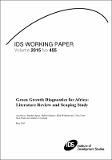| dc.contributor.author | Pueyo, Ana | |
| dc.contributor.author | Spratt, Stephen | |
| dc.contributor.author | Schmitz, Hubert | |
| dc.contributor.author | Willenbockel, Dirk | |
| dc.contributor.author | Dent, Chris | |
| dc.contributor.author | Wade, Neal | |
| dc.contributor.author | Crossland, Andrew | |
| dc.date.accessioned | 2015-05-27T08:29:32Z | |
| dc.date.available | 2015-05-27T08:29:32Z | |
| dc.date.issued | 2015-05-25 | |
| dc.identifier.isbn | 978 1 78118 236 9 | |
| dc.identifier.uri | https://opendocs.ids.ac.uk/opendocs/handle/20.500.12413/6168 | |
| dc.description.abstract | This paper reviews the literature for a project which seeks to develop a new Green
Growth Diagnostics methodology and apply it to countries in Africa.
The original growth diagnostics methodology was developed by Haussmann, Rodrik and
Velasco to identify the key constraints holding back economic growth from its full
potential. Their approach was driven by the needs of policymakers facing the dilemma
that most problems have multiple causes, but governments cannot tackle all of them at
once, given limitations in their financial and executive capacity. This gave rise to the idea
of concentrating these limited resources on the binding constraint, which would be
identified going through a tool conceptualised as a decision tree. The proponents of the
original growth diagnostics also realised that this binding constraint varies between
countries and - we would argue - between sectors.
The central point of the original growth diagnostics method was that it offered researchers
and policy makers a way of identifying priorities in analysis and policy; and finding
solutions which take into account local conditions. The same rationale applies to our
Green Growth Diagnostic project. We build on the original approach but adapt it in four
ways: 1. Applying it to the energy sector; 2. Taking into account potential knock-on effects
on the economy; 3. The political economy when going from diagnostics to therapeutics;
and 4. Working out the distributional consequences. Since each step takes the project
into un(der)explored territory, it is built around five research questions and corresponding
methodologically distinct work packages.
Our five research questions are: 1. What are the binding constraints for investment in
economically viable renewable energy?; 2.Which policies can more effectively target
different binding constraints?; 3. Who obstructs/drives the adoption of specific sustainable
energy policies?; 4. What would be the macroeconomic impacts of an increase in
renewable energy investment/capacity, and the reforms needed to bring this increase
about? and 5. Under what circumstances increased on-grid renewable energy capacity
translates into increased access to and increased reliability of electricity supply in
developing countries? This paper pulls together what we can learn from the international
literature on these questions. | en |
| dc.language.iso | en | en |
| dc.publisher | Institute of Development Studies | en |
| dc.relation.ispartofseries | IDS Working Paper;455 | |
| dc.rights | This publication is copyright, but may be reproduced by any method without fee for teaching or nonprofit purposes, but not for resale. Formal permission is required for all such uses, but normally will be granted immediately. For copying in any other circumstances, or for re- use in other publications, or for translation or adaptation, prior written permission must be obtained from the publisher and a fee may be payable. | en |
| dc.rights.uri | http://www.ids.ac.uk/files/dmfile/IDSOpenDocsStandardTermsOfUse.pdf | en |
| dc.subject | Climate Change | en |
| dc.title | Green Growth Diagnostics for Africa: Literature Review and Scoping Study | en |
| dc.type | IDS Working Paper | en |
| dc.rights.holder | Institute of Development Studies | en |
| dc.identifier.team | Green Transformations | en |

